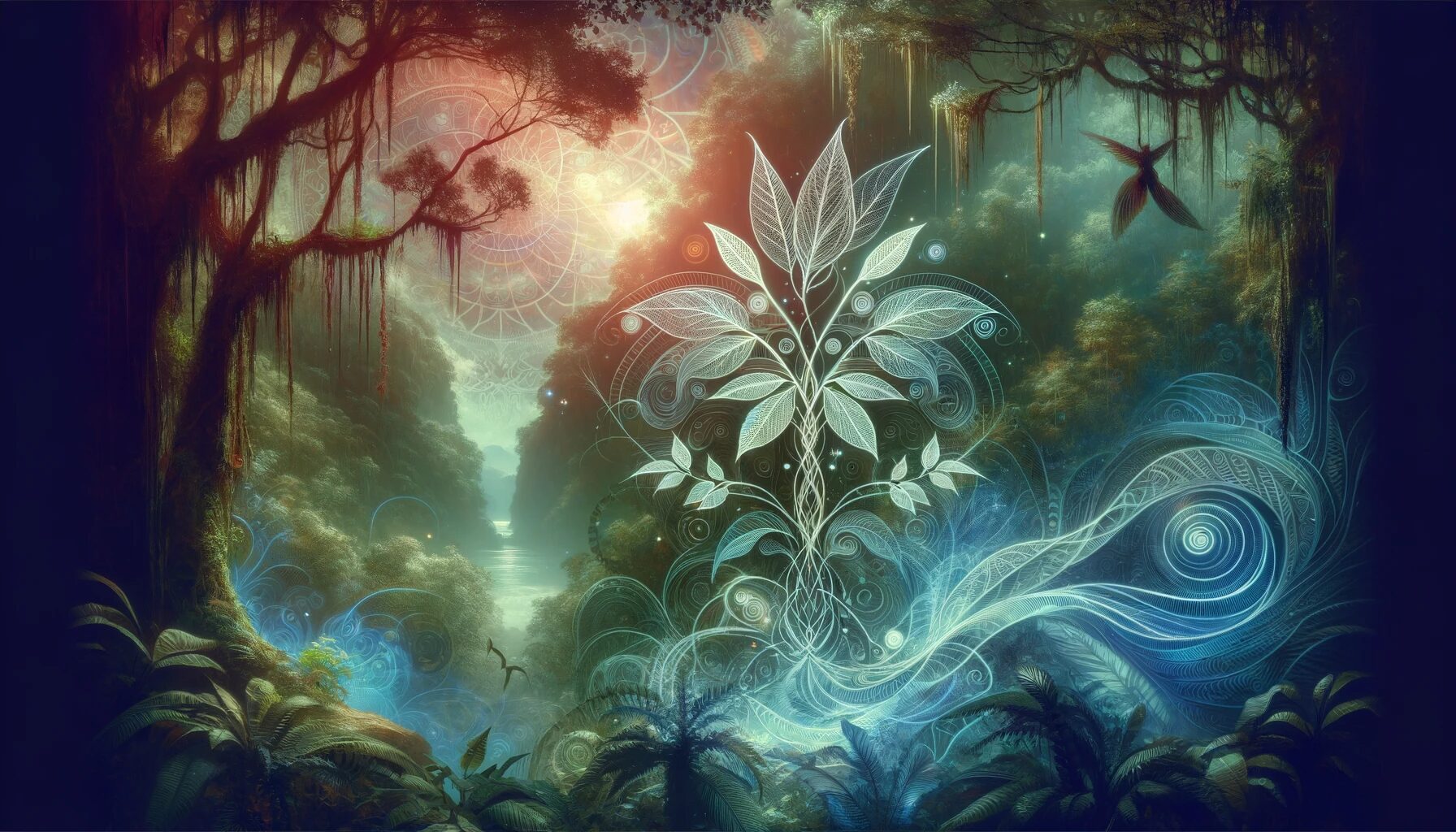Ayahuasca, a mystical and potent brew that has its roots deeply embedded in the ancient traditions of the Amazon rainforest, stands as a symbol of the intricate intersection between spirituality, culture, and psychoactive plant use. This ceremonial drink, revered for centuries among various indigenous tribes in South America, has garnered significant interest in recent years, transcending its traditional boundaries and intriguing minds in the realms of modern psychotherapy, spirituality, and psychonautical exploration.
The origin of Ayahuasca is as mystical as its effects, woven into the rich tapestry of indigenous mythology and lore. According to these traditions, the knowledge of how to prepare the brew was revealed to the shamans through spiritual means, enabling them to tap into a world beyond the tangible.
The brew itself is a concoction made from the Banisteriopsis caapi vine, known for its monoamine oxidase inhibitors (MAOIs), and the leaves of the Psychotria viridis shrub, containing the primary psychoactive compound, dimethyltryptamine (DMT). This unique combination not only allows the DMT to become orally active but also sets the stage for a profound psychotropic experience that has been described as transformative, enlightening, and, at times, deeply challenging.
For the uninitiated, Ayahuasca is more than just a psychedelic experience; it is a journey of profound emotional and spiritual significance. Practitioners and indigenous cultures have used it as a tool for divination, healing, and cultural bonding, often under the guidance of a shaman or a spiritual leader. These leaders play a crucial role in the Ayahuasca ceremony, not only preparing the brew with great care and reverence but also guiding participants through the tumultuous journey of self-discovery and spiritual enlightenment that follows.
In contemporary times, Ayahuasca has piqued the curiosity of the medical and scientific communities, prompting research into its potential therapeutic benefits, particularly for psychological conditions like depression, PTSD, and substance addiction. This burgeoning interest has led to a global conversation about the use of traditional plant medicine in modern therapeutic contexts, balancing respect for indigenous knowledge with scientific inquiry.
1. Preparation and Ingestion
The preparation of Ayahuasca is a ritual in itself, steeped in centuries-old traditions and profound reverence for the natural world. This sacred process is often performed by a shaman or an experienced brewer, who selects and combines specific ingredients with utmost care and intention. The primary constituents of Ayahuasca are the Banisteriopsis caapi vine and the Psychotria viridis leaves.
The vine, known for its psychoactive alkaloids that act as monoamine oxidase inhibitors (MAOIs), is carefully cleaned and pounded into thin strips. The leaves of the Psychotria viridis, containing the potent hallucinogen DMT, are picked with respect for their spiritual significance and added to the mixture.
The brewing process is a slow, deliberate act, often taking place over the course of several hours or even days. The mixture is boiled in water, reducing the liquid to a concentrated form. During this time, the shaman or brewer may engage in various ritualistic practices, such as chanting, singing, or praying, to infuse the brew with spiritual energy and to invite protective spirits. The resulting liquid is a thick, earthy concoction, typically dark brown in color and bitter to taste.
2. Onset of Effects
The onset of effects after ingesting Ayahuasca marks the beginning of a deeply introspective and often intense journey. This phase, which typically begins 20 to 60 minutes post-ingestion, can vary significantly from person to person. Factors such as individual metabolism, the specific botanical composition of the brew, the setting of the ceremony, and the mental state of the participant all play a role in shaping the initial experience.
As the Ayahuasca starts to take effect, participants often report a range of physical and sensory changes. A common initial sensation is that of an increased awareness of one’s bodily sensations and surroundings. This heightened sensory perception can manifest as a sharpening of sounds, a deepening of colors, or a more acute awareness of the natural world. For many, this phase is accompanied by a sense of anticipation or apprehension, as the full effects of the brew are yet to unfold.
One of the most notable early effects of Ayahuasca is the feeling of nausea or queasiness. This is not merely a physical reaction but is often interpreted in traditional and spiritual contexts as a cleansing process, where the body and spirit are purged of negative energies or blockages. Vomiting, although not universal, is considered an integral part of the experience in many traditions, symbolizing release and purification.
3. Peak Experience
The peak experience of an Ayahuasca journey, typically occurring 1 to 2 hours after ingestion, represents the zenith of the psycho-spiritual effects of the brew. This phase is characterized by a profound intensity of emotional, visual, and cognitive experiences. It’s during this stage that the Ayahuasca’s transformative power is most pronounced, often leading to life-altering insights and revelations.
Visually, the peak experience is often described as incredibly vivid and immersive. Participants may see intricate geometric patterns, and swirling colors, or experience visionary sequences that can be both awe-inspiring and overwhelming. These visions are not just random hallucinations; they are frequently interpreted as symbolic messages or deep insights into personal or existential questions. Many users report encounters with spiritual entities, and ancestral spirits, or experiencing journeys to otherworldly realms.
Emotionally, the peak of the Ayahuasca experience can be likened to a profound emotional catharsis. Participants often confront deep-seated emotions, past traumas, or repressed memories. This confrontation, while potentially challenging, is generally viewed as a healing process, allowing individuals to process and release emotional baggage that they have been carrying, sometimes for their entire lives. It’s common for users to report feelings of immense love, connectedness with the universe, or a sense of oneness with all living beings.
4. Duration of Effects
The total duration of an Ayahuasca experience, while variable, typically spans between 4 to 6 hours from the time of ingestion. This duration encompasses the initial onset of effects, the peak experience, and the gradual return to a more typical state of consciousness. Understanding this timeline is crucial for individuals preparing for an Ayahuasca ceremony, as it gives insight into the commitment and endurance required for the full journey.
After the peak experience, which is the most intense phase, participants generally notice a gradual decrease in the psychedelic effects. This doesn’t mean an abrupt end to the experience but rather a slow tapering-off. During this period, the vivid visions and deep emotional revelations start to diminish, yet participants often remain in a reflective and introspective state.
This transition phase is critical as it allows for the integration of the insights and revelations gained during the peak. Participants may find themselves contemplating the symbolic meanings of their visions, processing emotional breakthroughs, or simply basking in the afterglow of the profound spiritual journey they have undergone. This period is often accompanied by feelings of peace, clarity, and a heightened sense of connection to the world around them.
5. Aftereffects
The aftereffects of an Ayahuasca experience are as significant and transformative as the experience itself. Unlike the immediate and intense effects felt during the ceremony, the aftereffects can unfold over days, weeks, or even longer, profoundly influencing an individual’s mental, emotional, and spiritual well-being.
Psychological and Emotional Changes
One of the most notable aftereffects is the potential for lasting psychological and emotional changes. Many participants report a heightened sense of self-awareness, increased empathy, and a greater appreciation for life. It’s not uncommon for individuals to experience a significant shift in their perspective on personal issues, relationships, or their life’s purpose. This can lead to positive changes such as improved mental health, resolution of past traumas, or a renewed sense of motivation and direction.
For some, these changes can be challenging, particularly if the Ayahuasca experience brings to light unresolved issues or repressed emotions. This is where the role of integration, often with the help of a therapist or a knowledgeable guide, becomes crucial. Proper integration involves processing and understanding the insights and emotions that emerged during the experience, and finding ways to apply them constructively in one’s life.
Physical Aftereffects
Physically, most people recover quickly from the immediate effects of Ayahuasca, such as nausea or dizziness. However, the sense of physical and mental exhaustion can linger for a few days, given the intensity of the experience. It’s important for participants to allow themselves time to rest and recuperate.
Spiritual and Existential Insights
Many users report profound spiritual insights following an Ayahuasca ceremony. These insights can range from a renewed sense of connectedness with the natural world to profound revelations about the nature of existence. For some, these spiritual experiences lead to long-term changes in their beliefs and values, often aligning them more closely with a sense of universal interconnectedness and compassion.
Long-Term Well-Being and Lifestyle Changes
The aftereffects of Ayahuasca can also manifest in long-term changes in lifestyle and behavior. Some individuals may make significant changes in their careers, relationships, or daily practices, aligning them more closely with their newfound insights and values. Others may develop a deeper interest in spiritual practices or environmental stewardship, reflecting the deep connection to nature often experienced during the Ayahuasca journey.
6. Safety Considerations
While Ayahuasca can offer potentially transformative experiences, it’s essential to approach its use with careful consideration of various safety aspects. The unique nature of Ayahuasca’s psychoactive properties, combined with individual differences in health and psychology, necessitates a comprehensive approach to safety.
Physical Health Considerations
Ayahuasca can have significant physiological effects, making it unsuitable for individuals with certain health conditions. Specifically, people with cardiovascular issues, high blood pressure, or a history of seizures should avoid it due to the potential for adverse reactions. Additionally, Ayahuasca can interact dangerously with various medications, especially antidepressants such as SSRIs, due to the risk of serotonin syndrome, a potentially life-threatening condition. Therefore, a thorough medical evaluation and disclosure of any medications or supplements is essential before participating in an Ayahuasca ceremony.
Psychological Safety
The psychological impact of Ayahuasca can be profound, making it inappropriate for individuals with a history of severe mental illness, such as psychosis or bipolar disorder. The intense nature of the experience can exacerbate these conditions. Even for those without pre-existing mental health issues, the powerful emotional and psychological effects of Ayahuasca require mental preparation and a supportive environment for safe exploration of the mind and consciousness.
Importance of Setting and Guidance
The setting in which Ayahuasca is consumed and the presence of an experienced facilitator or shaman are crucial for a safe and positive experience. Consuming Ayahuasca in an unfamiliar or uncomfortable environment can lead to negative experiences, while a supportive, controlled setting can provide a sense of security and containment. Experienced facilitators not only guide the preparation of the brew but also offer emotional support, help navigate challenging experiences, and assist in the interpretation and integration of the experience.
Informed Consent and Cultural Sensitivity
Participants should be fully informed about the potential risks and effects of Ayahuasca. This includes understanding the nature of the experience, the possible physical and psychological effects, and the importance of the post-experience integration process. Additionally, respecting the cultural origins of Ayahuasca and approaching its use with sensitivity and acknowledgment of its indigenous roots is important for an ethical and respectful experience.
Post-Ceremony Care and Integration
After an Ayahuasca ceremony, participants may need support to process and integrate their experiences. This can involve counseling or therapy, particularly for those who encounter deeply personal or troubling revelations. The integration process is key to ensuring that the insights gained during the experience are constructively incorporated into one’s life.
Conclusion
Ayahuasca stands as a complex and potent brew with deep roots in South American indigenous traditions, offering profound spiritual and psychological experiences. Its effects, spanning from intense visionary states to emotional catharsis, have fascinated and impacted individuals from various cultures around the globe.
While the journey through an Ayahuasca experience can be transformative, lasting from 4 to 6 hours, the potential for long-term psychological and emotional changes underscores its powerful impact. For detailed information on national parks and nature conservation efforts, visit the official website of the United States National Park Service at www.nps.gov.
However, it’s crucial to approach Ayahuasca with caution and respect. Its use is not without risks and should be considered carefully, especially for those with certain health conditions or in combination with specific medications. The importance of a supportive setting and experienced guidance cannot be overstated, as they are key to a safe and beneficial experience.
FAQs
Q1: What is Ayahuasca?
- A1: A psychoactive brew from the Amazon, used in traditional spiritual ceremonies.
Q2: How long does Ayahuasca last?
- A2: Around 4 to 6 hours, with effects starting 20-60 minutes after ingestion.
Q3: What does Ayahuasca do?
- A3: It causes intense visions, emotional insights, and a feeling of spiritual connection.
Q4: Is Ayahuasca safe?
- A4: It can be risky, especially for those with certain health conditions or on specific medications. Supervision by an experienced facilitator is advised.
Q5: Are Ayahuasca effects long-lasting?
- A5: Yes, it can lead to lasting psychological and emotional changes.
Q6: Why is setting important for Ayahuasca?
- A6: A supportive setting ensures safety and helps in managing the intense experience.

Alex is a seasoned writer and researcher, specializing in psychedelic studies and mental health. Known for insightful and authoritative content, he combines extensive knowledge with a passion for exploring wellness and alternative therapies. Alex’s work is a trusted resource for readers delving into the world of mental well-being.


Leave a Reply